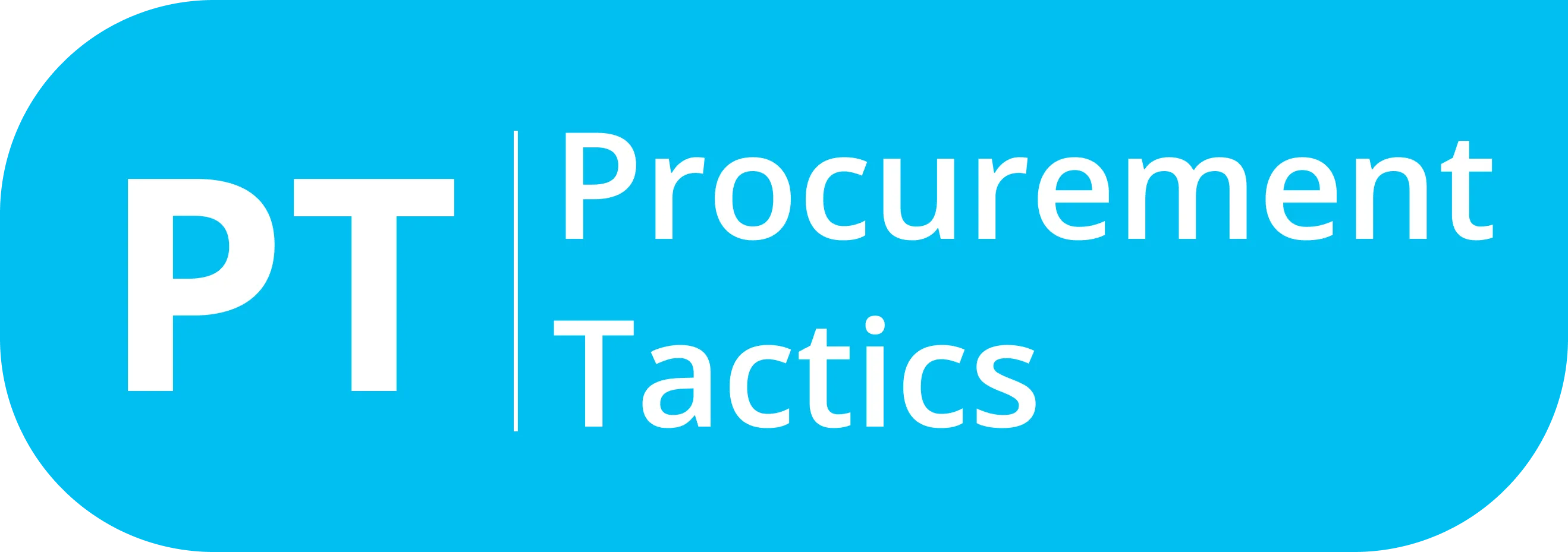Written by Marijn Overvest | Reviewed by Sjoerd Goedhart | Fact Checked by Ruud Emonds | Our editorial policy
B2B Procurement — Explained + Beginner’s Guide
What is B2B procurement?
- B2B procurement is about buying goods, services, or raw materials from other businesses.
- B2B emphasizes efficiency in cost-savings and quality assurance.
- AI reshapes B2B procurement by providing insights for streamlined processes and optimizing supplier performance.
What is B2B Procurement?
B2B procurement, or business-to-business procurement, refers to the process by which one business sources, negotiates, and acquires goods, services, or raw materials from another business. Unlike B2C (business-to-consumer) buying, B2B procurement involves larger transaction volumes, more complex decision-making, formal contracts, and ongoing supplier relationships.
At its core, B2B procurement includes the entire lifecycle of acquiring what a company needs to operate—from raw materials and equipment to logistics, software, or consulting services. It typically follows a multi-step process, like defining sourcing methodology, understanding the market, identifying suppliers, requesting quotes, evaluating offers, negotiating terms, sealing the agreement, and maintaining strong supplier relationships.
To put it simply, B2B procurement is how businesses buy from other businesses.
Here’s an example: Let’s say you are a part of the procurement team of a food manufacturer and every month you need to order packaging materials, cleaning supplies, and transportation services. Do you think your team will just click “buy”? No, as a procurement professional, your responsibility goes beyond just buying things; it’s also ensuring the right products or services are obtained from reliable suppliers at the correct cost.
Therefore, before a procurement team orders, they research suppliers, compare prices, check quality, create contracts, and track delivery while ensuring costs stay within budget and compliance rules are followed.
Unlike buying from a store as a customer, business procurement requires planning, documentation, and often collaboration between multiple departments like finance, operations, and legal. It’s rarely one-size-fits-all; each purchase might involve different suppliers, terms, or approval workflows.
Although many companies now use procurement platforms or e-procurement systems to streamline sourcing, automate supplier management, ensure contract compliance, and analyze spending that helps reduce manual work minimize errors, and help companies make better purchasing decisions.
What Makes B2B Procurement Effective
Each industry has unique requirements and challenges that influence their procurement processes. However, there are common things that can help you approach procurement processes strategically and effectively.
Here are some key factors in implementing effective B2B procurement:

1. Strategic Planning
Like most business processes, B2B procurement starts with a well-defined strategic plan. Make sure your plan should align with the organization’s goals and outlines the steps to achieve them. Include important factors like supplier relationships, cost management, risk assessment, and long-term value.
2. Supplier Relationship Management
Building strong and collaborative relationships with suppliers is crucial. Effective procurement involves selecting reliable suppliers, negotiating favorable terms, and fostering a partnership for mutual benefit. These relationships enhance transparency, communication, and responsiveness.
3. Sourcing and Selection
Perform careful supplier selection based on a thorough evaluation of factors such as product quality, pricing, delivery capabilities, financial stability, and compliance with standards. A strategic sourcing approach will help in choosing the right suppliers.
4. Cost Efficiency
Effective B2B procurement seeks to achieve cost savings while maintaining product quality and service levels. This includes negotiation, volume discounts, competitive bidding, and evaluating total cost of ownership.
5. Risk Mitigation
Effective procurement anticipates and manages risks. This includes identifying potential supply chain disruptions, assessing supplier stability, and having contingency plans in place to handle unforeseen situations.
6. Contract Management
Effective procurement ensures that contracts cover all necessary terms (pricing, delivery schedules, quality standards, dispute resolution, compliance requirements, etc.). These contracts provide a foundation for a successful partnership.
7. Continuous Improvement
Regularly reviewing and refining procurement practices, monitoring supplier performance, and seeking opportunities for improvement are essential. This ensures that the organization remains adaptable and responsive to changing market conditions.
B2C vs B2B Procurement
B2C (business-to-consumer) and B2B (business-to-business) procurement differ in their nature and so, each has its own approach, each tailored to the specific needs of their respective markets.
Let’s compare these two procurement models:
The B2B Procurement Process
In B2B procurement, buying is not a single act; it’s a structured, multi-step process that ensures a business makes the right purchasing decisions, at the right time, with the right suppliers. Below is a breakdown of the seven essential steps involved in the B2B procurement process:
1. Sourcing Methodology
The first step in the process is defining the sourcing strategy. In B2B procurement, this step involves analyzing what the business needs, setting clear goals, and securing support from key stakeholders such as finance, operations, or legal.
A cross-functional team is typically formed to gather data like spend history, supplier performance, and business requirements.
This data-driven approach lays the foundation for choosing the most suitable sourcing method, such as competitive bidding or direct negotiation.
In B2B, this phase is critical because the purchasing decisions often affect supply chain continuity, cost structure, and long-term supplier relationships.
2. Market Research
In this step, procurement professionals conduct in-depth market research to understand supply options, pricing trends, industry benchmarks, and supplier availability.
For example, if a company is sourcing components for industrial machinery, it needs to analyze which vendors offer the required quality, delivery capabilities, certifications, and support services.
In B2B procurement, market research is vital for risk management and helps avoid supplier concentration or over-reliance on a single vendor. It also helps avoid costly surprises and builds leverage for later negotiations.
3. Request for Information (RFI)
Once the market research is done, the next step that procurement does is to issue a request for information (RFI) to potential suppliers.
The RFI helps clarify supplier capabilities and align internal stakeholder needs, such as technical specifications, budget expectations, delivery timeframes, and compliance requirements.
This step is crucial in B2B environments because it enables the organization to pre-qualify suppliers before inviting formal bids.
It also ensures that when a company proceeds to the next phase, it is engaging only with vendors who can truly meet the need.
4. Request for Quotation (RFQ)
Following the RFI, procurement teams send out a request for quotation (RFQ) to shortlisted suppliers.
The RFQ is a formal document asking suppliers to provide pricing, delivery schedules, service-level expectations, penalties for underperformance, and other commercial terms.
In B2B procurement, the RFQ process is often tightly managed, as purchases may involve multi-year contracts, high-volume pricing structures, or bundled service offerings.
This stage ensures cost transparency, competitive benchmarking, and alignment between the buyer’s operational needs and the supplier’s offering.
5. Negotiation Phase
Negotiation in B2B procurement is where significant value is created or lost. In this phase, it’s not only about price but also about payment terms, delivery guarantees, quality expectations, warranties, and escalation clauses.
Procurement professionals rely on insights from previous steps, like market research and internal data, to negotiate contracts that balance cost savings with value creation.
Successful negotiation not only lowers cost but also reduces supply chain risks and builds stronger supplier collaboration.
6. Contracting Phase
Once agreement is reached, a formal contract is signed. The contract outlines all agreed terms, from pricing and product specifications to dispute resolution clauses and regulatory compliance.
In B2B procurement, the contract serves as a governance tool, offering clarity, protecting both parties, and enabling performance tracking.
Legal teams are often involved in this phase to ensure alignment with company policies and local or international laws.
7. Supplier Relationship Management (SRM)
B2B procurement doesn’t end with the contract. In fact, that’s where long-term value creation begins.
Supplier relationship management (SRM) involves procurement teams actively monitoring supplier performance, measuring KPIs, resolving issues, conducting regular review meetings, and collaborating on continuous improvement.
In industries such as manufacturing, healthcare, and IT, relationships with suppliers are strategic rather than merely transactional.
A strong SRM approach helps maintain supply continuity, manage risks, foster innovation, and unlock cost savings over time.
B2B Procurement Trends in 2026
As a procurement professional, you have to remain competitive by continuously learning and upskilling. Accessing industry reports, and business news sources, attending procurement conferences, and participating in industry networks are among the few ways to stay informed about the latest in B2B procurement. The procurement trends in 2026 include:
1. AI-driven Analytics
AI is reshaping business processes including B2B procurement. AI-driven analytics offer insights that help streamline purchasing processes and optimize supplier performance.
2. Supplier Relationship Management
The importance of building and nurturing strategic partnerships with suppliers is paramount. It enhances collaboration, innovation, and mutual growth.
3. Sustainability and Ethical Sourcing
More and more businesses are prioritizing sustainability and ethical considerations. There is a growing demand for suppliers who align with responsible practices.
4. Risk Management
Disruptions and uncertainties require a proactive approach to risk management. That said, the ability to identify and mitigate supply chain risks is of great importance.
5. Diversifying Supply Chain
With global markets expanding, it is practical to have multiple suppliers instead of one. This diversification of supply chains can mitigate supply chain problems cause by disruptions and ensure continuity of operations.
6. E-Procurement Solutions
Due to uncertainties and unexpected disruptions, adopting online and digital solutions is a necessary move for effective B2B procurement.
E-procurement solutions include automation, purchase order integration, catalog management, e-Tendering, order status, contract management, vendor management, e-Auctioning, ship notice, e-Invoicing, e-Payment, Saas marketing for B2Bs, and regulatory compliance.
Conclusion
B2B procurement is not just the process of acquiring goods and services; it’s also about procuring high-quality products by establishing strategic relationships with qualified suppliers.
As a procurement professional, you’re not merely a buyer; but you’re also responsible for managing the complexities of the supply chain process.
It is important that you keep the key factors in implementing effective B2B procurement, which are: strategic planning, supplier relationship management, sourcing and selection, cost efficiency, risk mitigation, contract management, and continuous improvement.
Frequentlyasked questions
What is B2B procurement?
Refers to the process of acquiring goods, services, or raw materials from one business to another.
What is the responsibility of a procurement professional in B2B procurement?
To ensure the right products or services are obtained from reliable suppliers at the correct cost.
What are the main e-procurement functions?
Purchase order integration, catalog management, e-Tendering, order status, contract management, vendor management, e-Auctioning, ship notice, e-Invoicing, e-Payment, and regulatory compliance.
About the author
My name is Marijn Overvest, I’m the founder of Procurement Tactics. I have a deep passion for procurement, and I’ve upskilled over 200 procurement teams from all over the world. When I’m not working, I love running and cycling.






